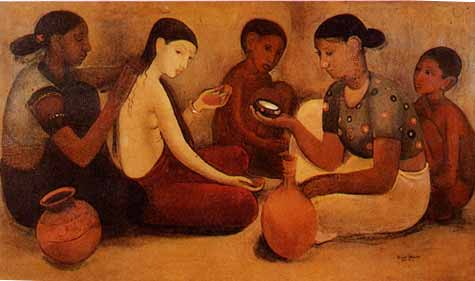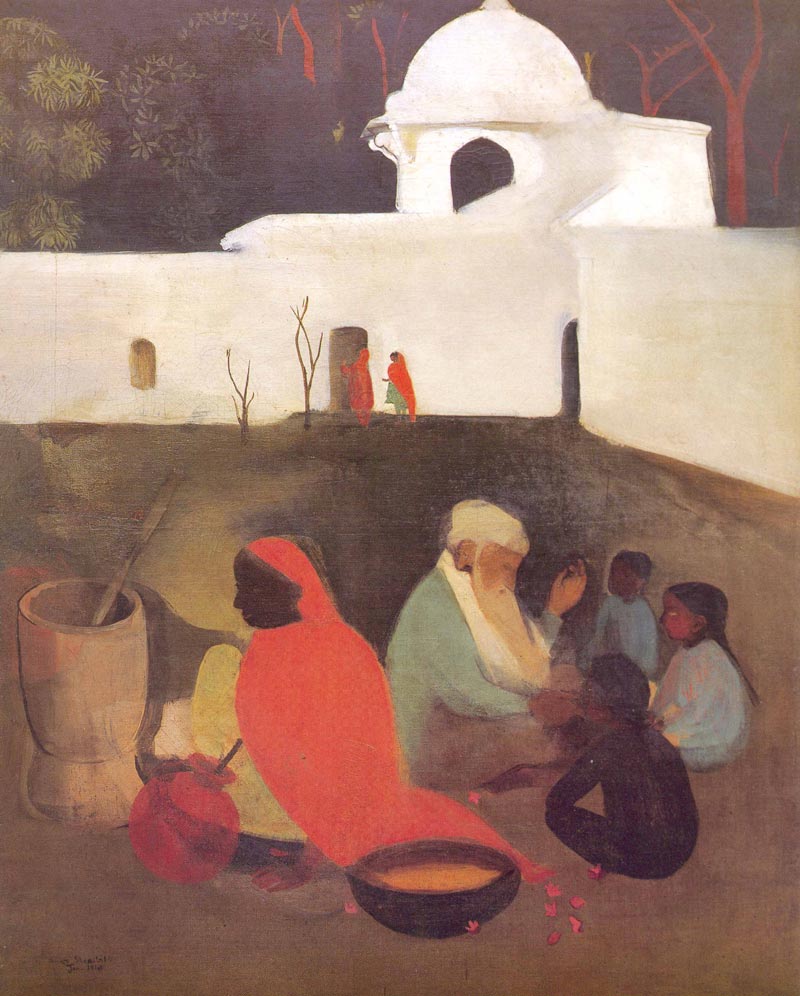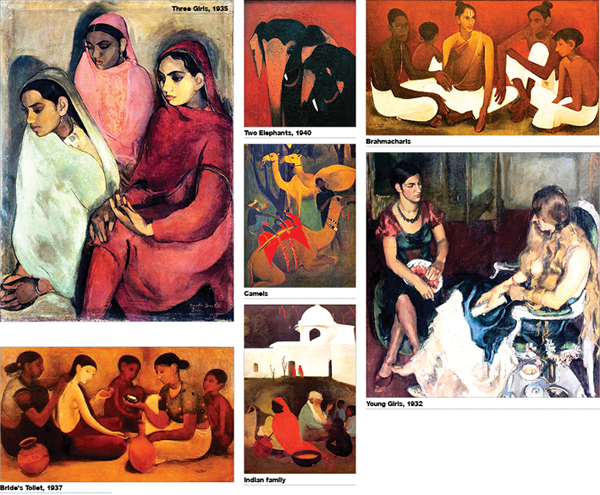Amrita Sher- Gil,


-ಚರಿತಾ
krupe:vijaya karnataka
ಭಾರತದ ಚಿತ್ರಕಲೆಯ ಲೋಕ ಕಂಡ
ಅನನ್ಯ ಮತ್ತು ಅಪೂರ್ವ ಧೈರ್ಯದ ಕಲಾವಿದೆ ಎಂದರೆ, ಅಮೃತಾ ಶೇರ್ಗಿಲ್. ಆಕೆ ಬದುಕಿದ್ದು
ಕೇವಲ ಇಪ್ಪತ್ತೆಂಟು ವರುಷಗಳಷ್ಟೆ. ಆದರೆ, ಅಷ್ಟರಲ್ಲಿ ಬದುಕಿನಲ್ಲಿ ಅನುಭವಿಸಿದ
ಪ್ರಕ್ಷುಬ್ಧತೆ, ಪ್ರದರ್ಶಿಸಿದ ಬಂಡುಕೋರತನ, ಮುಖಾಮುಖಿಯಾದ ಸಂಬಂಧಗಳು ಇವೆಲ್ಲದರ
ತೀವ್ರತೆ ಮತ್ತು ಬೀಸು ದೊಡ್ಡದು. ಹಾಗೆಯೇ ಕುಂಚವನ್ನು ಹಿಡಿದು ಸಾಧಿಸಿದ್ದು ಅಪಾರ. ಈಗ
ಇದ್ದಿದ್ದರೆ ಅಮೃತಾಗೆ ನೂರಾಒಂದು ವರುಷವಾಗಿರುತ್ತಿತ್ತು (ಜನನ: ಜ.30, 1913).
ಬೆಂಗಳೂರಿನ ಎನ್ಜಿಎಂಎಯಲ್ಲಿ ಸದ್ಯಕ್ಕೆ ಅಮೃತಾಳ ಚಿತ್ರಗಳ ಪ್ರದರ್ಶನ 'ದಿ ಪ್ಯಾಷನೇಟ್
ಕ್ವೆಸ್ಟ್' ನಡೆಯುತ್ತಿದೆ. ಇವೆಲ್ಲಾ ಹಿನ್ನೆಲೆಯಲ್ಲಿ ಅವರ ಜೀವನ-ಚಿತ್ರಗಳ ಸಮಾಚಾರ
ಇಲ್ಲಿದೆ.
-----
 ಸೆರಗು
ಹೊದ್ದ ಬೈತಲೆಯ ಕೆಳಗೆ ತುಸು ಹೆಚ್ಚು ಅನಿಸುವಷ್ಟು ಅಗಲದ ಹಣೆ, ಇದಕ್ಕೆ ಫ್ರೇಮ್
ಹಾಕಿದಂತೆ ಕಾಣುವ ತಲೆಗೂದಲು, ಅವಳ ಸಂಕಟವನ್ನೇ ಗೆರೆ ಎಳೆದು ಶೇಪ್ ಮಾಡಿಟ್ಟ ಹುಬ್ಬು,
ಹುಬ್ಬುಗಳ ನಡುಮಧ್ಯೆ ಪುಟ್ಟಬೊಟ್ಟು ; ಹಠಮಾರಿತನವೇ ಆಕಾರ ಪಡೆದಂತಿರುವ ಮೂಗು,
ಕಂಡೂಕಾಣದ ಸಣ್ಣ ಮೀಸೆಗೆರೆ, ಸುಂದರ ತುಟಿಗಳಲ್ಲಿ ಹೆಪ್ಪುಗಟ್ಟಿದಂತಿರುವ ಅವಳ ಜಂಭ
ಮತ್ತು ಸೌಂದರ್ಯ, ತುಟಿಯಿಂದ ಕೆನ್ನೆಗೆ ಹರಡಿರುವ ಆತ್ಮವಿಶ್ವಾಸದ ಎಳೆ, ಕಪ್ಪು ವರ್ತುಲದ
ನಡುವೆ ನೇರ ನನ್ನನ್ನೇ ದಿಟ್ಟಿಸುತ್ತಿರುವ ನೋಟದ ಆಳ... 'ನಾನು, ಅಮೃತಾ'
ಎನ್ನುವಂತಿರುವ ನಿಲುವಿನ ಆ ಭಂಗಿ...
ಸೆರಗು
ಹೊದ್ದ ಬೈತಲೆಯ ಕೆಳಗೆ ತುಸು ಹೆಚ್ಚು ಅನಿಸುವಷ್ಟು ಅಗಲದ ಹಣೆ, ಇದಕ್ಕೆ ಫ್ರೇಮ್
ಹಾಕಿದಂತೆ ಕಾಣುವ ತಲೆಗೂದಲು, ಅವಳ ಸಂಕಟವನ್ನೇ ಗೆರೆ ಎಳೆದು ಶೇಪ್ ಮಾಡಿಟ್ಟ ಹುಬ್ಬು,
ಹುಬ್ಬುಗಳ ನಡುಮಧ್ಯೆ ಪುಟ್ಟಬೊಟ್ಟು ; ಹಠಮಾರಿತನವೇ ಆಕಾರ ಪಡೆದಂತಿರುವ ಮೂಗು,
ಕಂಡೂಕಾಣದ ಸಣ್ಣ ಮೀಸೆಗೆರೆ, ಸುಂದರ ತುಟಿಗಳಲ್ಲಿ ಹೆಪ್ಪುಗಟ್ಟಿದಂತಿರುವ ಅವಳ ಜಂಭ
ಮತ್ತು ಸೌಂದರ್ಯ, ತುಟಿಯಿಂದ ಕೆನ್ನೆಗೆ ಹರಡಿರುವ ಆತ್ಮವಿಶ್ವಾಸದ ಎಳೆ, ಕಪ್ಪು ವರ್ತುಲದ
ನಡುವೆ ನೇರ ನನ್ನನ್ನೇ ದಿಟ್ಟಿಸುತ್ತಿರುವ ನೋಟದ ಆಳ... 'ನಾನು, ಅಮೃತಾ'
ಎನ್ನುವಂತಿರುವ ನಿಲುವಿನ ಆ ಭಂಗಿ...
ಕಪ್ಪು-ಬಿಳುಪಿನ ಈ ಫೋಟೊ ನೋಡುತ್ತ, ಅವಳ ಕಣ್ಣಳವಿನ ಜಾಡು ಹುಡುಕುತ್ತ, ದಿಟ್ಟಿಸುತ್ತಲೇ ಇದ್ದೇನೆ. ವ್ಯಾನ್ಗೋನ ಸುಡುವ ಹಳದಿಯಂತೆ, ಬೆಳಕಿನ ಉಂಡೆಯಂತೆ ಉರಿದುರಿದು ಬದುಕು ಬಸಿದ ಹುಡುಗಿ ಇವಳು. ಗಾಢ ಹಸಿರು, ಕೆಂಪು, ಹಳದಿಗಳಲ್ಲಿ 'ಅಮೃತಳಾದ' ಕಡುಚೆಲುವೆ.
-----
 ಸೆರಗು
ಹೊದ್ದ ಬೈತಲೆಯ ಕೆಳಗೆ ತುಸು ಹೆಚ್ಚು ಅನಿಸುವಷ್ಟು ಅಗಲದ ಹಣೆ, ಇದಕ್ಕೆ ಫ್ರೇಮ್
ಹಾಕಿದಂತೆ ಕಾಣುವ ತಲೆಗೂದಲು, ಅವಳ ಸಂಕಟವನ್ನೇ ಗೆರೆ ಎಳೆದು ಶೇಪ್ ಮಾಡಿಟ್ಟ ಹುಬ್ಬು,
ಹುಬ್ಬುಗಳ ನಡುಮಧ್ಯೆ ಪುಟ್ಟಬೊಟ್ಟು ; ಹಠಮಾರಿತನವೇ ಆಕಾರ ಪಡೆದಂತಿರುವ ಮೂಗು,
ಕಂಡೂಕಾಣದ ಸಣ್ಣ ಮೀಸೆಗೆರೆ, ಸುಂದರ ತುಟಿಗಳಲ್ಲಿ ಹೆಪ್ಪುಗಟ್ಟಿದಂತಿರುವ ಅವಳ ಜಂಭ
ಮತ್ತು ಸೌಂದರ್ಯ, ತುಟಿಯಿಂದ ಕೆನ್ನೆಗೆ ಹರಡಿರುವ ಆತ್ಮವಿಶ್ವಾಸದ ಎಳೆ, ಕಪ್ಪು ವರ್ತುಲದ
ನಡುವೆ ನೇರ ನನ್ನನ್ನೇ ದಿಟ್ಟಿಸುತ್ತಿರುವ ನೋಟದ ಆಳ... 'ನಾನು, ಅಮೃತಾ'
ಎನ್ನುವಂತಿರುವ ನಿಲುವಿನ ಆ ಭಂಗಿ...
ಸೆರಗು
ಹೊದ್ದ ಬೈತಲೆಯ ಕೆಳಗೆ ತುಸು ಹೆಚ್ಚು ಅನಿಸುವಷ್ಟು ಅಗಲದ ಹಣೆ, ಇದಕ್ಕೆ ಫ್ರೇಮ್
ಹಾಕಿದಂತೆ ಕಾಣುವ ತಲೆಗೂದಲು, ಅವಳ ಸಂಕಟವನ್ನೇ ಗೆರೆ ಎಳೆದು ಶೇಪ್ ಮಾಡಿಟ್ಟ ಹುಬ್ಬು,
ಹುಬ್ಬುಗಳ ನಡುಮಧ್ಯೆ ಪುಟ್ಟಬೊಟ್ಟು ; ಹಠಮಾರಿತನವೇ ಆಕಾರ ಪಡೆದಂತಿರುವ ಮೂಗು,
ಕಂಡೂಕಾಣದ ಸಣ್ಣ ಮೀಸೆಗೆರೆ, ಸುಂದರ ತುಟಿಗಳಲ್ಲಿ ಹೆಪ್ಪುಗಟ್ಟಿದಂತಿರುವ ಅವಳ ಜಂಭ
ಮತ್ತು ಸೌಂದರ್ಯ, ತುಟಿಯಿಂದ ಕೆನ್ನೆಗೆ ಹರಡಿರುವ ಆತ್ಮವಿಶ್ವಾಸದ ಎಳೆ, ಕಪ್ಪು ವರ್ತುಲದ
ನಡುವೆ ನೇರ ನನ್ನನ್ನೇ ದಿಟ್ಟಿಸುತ್ತಿರುವ ನೋಟದ ಆಳ... 'ನಾನು, ಅಮೃತಾ'
ಎನ್ನುವಂತಿರುವ ನಿಲುವಿನ ಆ ಭಂಗಿ...ಕಪ್ಪು-ಬಿಳುಪಿನ ಈ ಫೋಟೊ ನೋಡುತ್ತ, ಅವಳ ಕಣ್ಣಳವಿನ ಜಾಡು ಹುಡುಕುತ್ತ, ದಿಟ್ಟಿಸುತ್ತಲೇ ಇದ್ದೇನೆ. ವ್ಯಾನ್ಗೋನ ಸುಡುವ ಹಳದಿಯಂತೆ, ಬೆಳಕಿನ ಉಂಡೆಯಂತೆ ಉರಿದುರಿದು ಬದುಕು ಬಸಿದ ಹುಡುಗಿ ಇವಳು. ಗಾಢ ಹಸಿರು, ಕೆಂಪು, ಹಳದಿಗಳಲ್ಲಿ 'ಅಮೃತಳಾದ' ಕಡುಚೆಲುವೆ.

Three Girls by Amrita Sher-Gil
ಭಾರತದ ಆಧುನಿಕ ಕಲೆಯ ವಕ್ತಾರರಲ್ಲಿ ರವೀಂದ್ರನಾಥ ಟ್ಯಾಗೋರ್, ಜ್ಯಾಮಿನಿ ರಾಯ್ ಜೊತೆಗೆ ಕೇಳಿಬರುವ ಮುಂಚೂಣಿಯ ಹೆಸರು-ಅಮೃತಾ ಶೇರ್ಗಿಲ್. ತನ್ನ ಹದಿನಾರನೆಯ ಎಳೆವಯಸ್ಸಿಗೇ ಪ್ಯಾರಿಸ್ಸಿನ ಹೆಸರಾಂತ ಕಲಾಶಾಲೆಯಲ್ಲಿ ಕಲಿತವಳು. ಅಲ್ಲಿನ ಪ್ರತಿಷ್ಠಿತ ಸಲಾನ್ನಲ್ಲಿ ವಿಶೇಷ ಪ್ರಶಸ್ತಿ ಮತ್ತು ಸದಸ್ಯತ್ವ ದಕ್ಕಿಸಿಕೊಂಡ ಪ್ರತಿಭಾವಂತೆ.

"Portrait of a Young Man" by Amrita Sher-Gil, 1930.
ಪಂಜಾಬ್ ಮೂಲದ, ಸಿಖ್ ಸಮುದಾಯದ ತತ್ತ್ವಜ್ಞಾನಿ ತಂದೆ- ಉಮ್ರಾವ್ ಶೇರ್ಗಿಲ್ ನೆನಪಿಸಿಕೊಳ್ಳುವಂತೆ, ಪುಟ್ಟ ಅಮೃತಾ ಬೇರೆಲ್ಲ ಮಕ್ಕಳಂತೆ ಒಂದೇ ಸಮ ರಂಪ ಮಾಡುವುದಾಗಲಿ, ಅಳುವುದಾಗಲಿ ಮಾಡದೆ, ತನ್ನ ಅಷ್ಟಗಲ ಕಣ್ಣು ತೆರೆದು, ಕಂಡದ್ದನ್ನೆಲ್ಲ ಕಬಳಿಸುವಂತೆ ನೋಡುತ್ತಿದ್ದಳಂತೆ. ಅದಕ್ಕೇ ಇರಬೇಕು- ಬದುಕಿನುದ್ದಕ್ಕೂ ಆ ಕಣ್ಣುಗಳ ಆಳ, ಅಳವಿಗೆ ದಕ್ಕಿದ್ದೆಲ್ಲವೂ ಚಿತ್ರಗಳಾಗಿ ಹೋದವು! ಆ ಚಿತ್ರಗಳ ಮೂಲಕ ಹಲವು ಕಣ್ಣುಗಳು ಮತ್ತೆ ತೆರೆದುಕೊಂಡವು.
ಅವಳ ಅಮ್ಮ ಹಂಗೇರಿ ಮೂಲದ ಸಂಗೀತಗಾರ್ತಿ, ಪಿಯಾನೋ ವಾದಕಿ ಮೇರಿ ಆ್ಯಂಟೊನೆ. ಅಮ್ಮ ಹೇಳುತ್ತಿದ್ದ ಕಥೆ, ಹಾಡುಗಳಿಗೆ ಕಾಲ್ಪನಿಕ ಚಿತ್ರಗಳನ್ನು ಬರೆಯುತ್ತಿದ್ದ ಎಳೆಹುಡುಗಿ ಈಕೆ. ಹಂಗೇರಿಯ ಬುಡಾಪೆಸ್ಟ್ನಲ್ಲಿ ಜನವರಿ 30, 1913ರಲ್ಲಿ ಕಣ್ಣುಬಿಟ್ಟ ಕೂಸು ಅಮೃತಾ. 1921ರಲ್ಲಿ ಭಾರತಕ್ಕೆ ಬಂದ ಕುಟುಂಬ ಸಿಮ್ಲಾದಲ್ಲಿ ನೆಲೆ ನಿಂತಿತು. ಮನೆಯಲ್ಲಿ ಪಿಯಾನೊ ನುಡಿಸುತ್ತ, ಚಿತ್ರ ಬರೆಯುತ್ತ, ಅಮ್ಮ ಮತ್ತು ತಂಗಿ ಇಂದಿರಾ ಜೊತೆ ಪ್ರವಾಸಿ ತಾಣಗಳಿಗೆ ಪಿಕ್ನಿಕ್ ಮಾಡುತ್ತ ಬೆಳೆದವಳು ಅಮೃತಾ. ಭೀತಿ ಹುಟ್ಟಿಸುತ್ತಿದ್ದ ಅಪ್ಪ-ಅಮ್ಮನ ಜಗಳಗಳು, ಪೇಲವ ದಿನಚರಿ, ಅತಿ ಅನಿಸುವ ಶಿಸ್ತು ಎಳೆಯ ಅಮೃತಾಳಲ್ಲಿ ಒಬ್ಬ ಅಂತರ್ಮುಖಿಯನ್ನು, ಬಂಡುಗಾರ್ತಿಯನ್ನು, ಹಟಮಾರಿಯನ್ನು ಹುಟ್ಟುಹಾಕಿರಬೇಕು.

ಅಮೃತಾಗೆ ದೊರೆತ
ಬಹುದೊಡ್ಡ ಬಿಡುಗಡೆಯೆಂದರೆ, ಬಹುಶಃ ಆಕೆಯ ಪ್ಯಾರಿಸ್ ದಿನಗಳು. ಸೆಜಾನ ಸೇಬುಗಳು,
ಗಾಗಿನ್ನ ತಾಹಿತಿಯನ್ ಪ್ಯಾಲೆಟ್, ವ್ಯಾನ್ಗೋನ ಉರಿಹಬ್ಬಿಸುವ ಬಣ್ಣಗಳು, ಮಾಂಡ್ರಿಯನ್
ಮತ್ತು ಎಲ್ಗ್ರೆಕೋನ ನೀಳಕಾಯದ ಚಿತ್ರಗಳು, ಬ್ರುಗೆಲ್ ಶೈಲಿಯ ಸಂಯೋಜನೆ, ಪಿಕಾಸೊ
ರೂಢಿಸಿಕೊಂಡಿದ್ದ 'ಕಲರ್ ಪೀರಿಯಡ್'ನ ಗುಂಗು- ಇವೆಲ್ಲದರ ಪ್ರಭಾವದಡಿಯಲ್ಲಿ ಇವಳೊಳಗಿನ
ಚಿತ್ರಗಾರ್ತಿ ರೂಪುಗೊಂಡಿದ್ದಳು. ಎಲ್ಲಕ್ಕಿಂತ ಮಿಗಿಲಾಗಿ ಅಲ್ಲಿನ ಕಲಾಶಾಲೆಯಲ್ಲಿ
ದೊರೆತ ಅಭಿವ್ಯಕ್ತಿ ಸ್ವಾತಂತ್ರ್ಯ ಇವಳ ಆಂತರ್ಯದ ಹಪಾಹಪಿಗೆ ಕನ್ನಡಿ ಹಿಡಿದಿತ್ತು.

1929ರಿಂದ 1934ರವರೆಗಿನ ಐದು ವರ್ಷಗಳ ಪ್ಯಾರಿಸ್ ಅನುಭವದಲ್ಲಿ ಹುಟ್ಟಿಕೊಂಡಿದ್ದು ನಿಗಿನಿಗಿಸುವ ಜೀವಂತಿಕೆಯ ಚಿತ್ರಗಳು. ಮುಖ್ಯವಾಗಿ ಸೆಲ್ಫ್ ಪೋರ್ಟ್ರೇಟ್ (ಸ್ವ-ಭಾವಚಿತ್ರ) ನ್ಯೂಡ್ ಸ್ಟಡಿ ಮತ್ತು ಪರಿಚಿತರ ಭಾವಚಿತ್ರಗಳು. ಯೌವನದ ಉತ್ತುಂಗ ಸ್ಥಿತಿಯಲ್ಲಿದ್ದ ಹುಡುಗಿ ಈಕೆ. ಜೊತೆಗೆ ಬಂಡುಕೋರ ಮನಃಸ್ಥಿತಿ. ಕಲೆ, ಸಾಹಿತ್ಯ, ಫ್ಯಾಷನ್, ರಾಜಕೀಯ-- ಒಟ್ಟಾರೆ ಸೃಜನಶೀಲ ಯುವಮನಸುಗಳ ಪೋಷಕತಾಣವಾಗಿದ್ದ ಪ್ಯಾರಿಸ್ನಂಥ ಉರಿಯೌವನದ ನಗರಿ ಈ ಹುಡುಗಿಯಲ್ಲಿನ ಕಿಚ್ಚಿಗೆ ತಿದಿಯೊತ್ತಿತ್ತು. ಬೆಂಕಿಯನ್ನು ಬೆಳಕಿನಂತೆ ಉರಿಸಿತ್ತು.
 ಬೆತ್ತಲೆ ದೇಹದ ಚಿತ್ರಾಭ್ಯಾಸ ಅಲ್ಲಿನ ಪಠ್ಯಕ್ರಮದ
ಭಾಗವೇ ಆಗಿತ್ತಾದರೂ ಈ ಪಠ್ಯದ ಹೊರತಾಗಿಯೂ ರಚನೆಗೊಂಡ ಚಿತ್ರಗಳು ಅಮೃತಾಳ ಒಳಗೆ
ಇದ್ದಿರಬಹುದಾದ ಒಂದು 'ಗಂಡು ನೋಟ'ವನ್ನು ಸಾಕ್ಷೀಕರಿಸುತ್ತವೆ (1933ರಲ್ಲಿ ರಚನೆಗೊಂಡ
ನ್ಯೂಡ್ ಚಿತ್ರಗಳು). ವಿಶೇಷವೆಂದರೆ, ಈ ಕಾಲಘಟ್ಟದಲ್ಲಿ ರಚನೆಗೊಂಡ ಗಂಡಸಿನ ಚಿತ್ರಗಳು
ನೋಡುಗರನ್ನು ನೇರವಾಗಿ ದಿಟ್ಟಿಸದೆ ಅನ್ಯಮನಸ್ಕರಂತೆ, ಶರಣಾಗತ ಭಾವದಲ್ಲಿದ್ದಂತೆ
ಕಾಣುತ್ತವೆ. ಹೆಂಗಸರ ಚಿತ್ರಗಳಲ್ಲಿ ಕಾಣುವ ಉದ್ರೇಕತೆ, ಆಕ್ರಮಣಕಾರಿ ಕಾಮುಕತೆಯ ನೋಟ ಈ
ಗಂಡು ಚಿತ್ರಗಳಲ್ಲಿಲ್ಲ ('ಯಂಗ್ ಮ್ಯಾನ್ ವಿತ್ ಆ್ಯಪಲ್' ಮತ್ತು 'ಪೋರ್ಟ್ರೇಟ್ ಆಫ್ ಎ
ಯಂಗ್ಮ್ಯಾನ್') ಬೋರಿಸ್ ತಾಸ್ಲಿಸ್ಕಿ ಎಂಬ ಈಕೆಯ ಸಹಪಾಠಿ ಹುಡುಗ ಈ ಚಿತ್ರಗಳ ಮಾಡೆಲ್
ಆಗಿದ್ದವನು.
ಬೆತ್ತಲೆ ದೇಹದ ಚಿತ್ರಾಭ್ಯಾಸ ಅಲ್ಲಿನ ಪಠ್ಯಕ್ರಮದ
ಭಾಗವೇ ಆಗಿತ್ತಾದರೂ ಈ ಪಠ್ಯದ ಹೊರತಾಗಿಯೂ ರಚನೆಗೊಂಡ ಚಿತ್ರಗಳು ಅಮೃತಾಳ ಒಳಗೆ
ಇದ್ದಿರಬಹುದಾದ ಒಂದು 'ಗಂಡು ನೋಟ'ವನ್ನು ಸಾಕ್ಷೀಕರಿಸುತ್ತವೆ (1933ರಲ್ಲಿ ರಚನೆಗೊಂಡ
ನ್ಯೂಡ್ ಚಿತ್ರಗಳು). ವಿಶೇಷವೆಂದರೆ, ಈ ಕಾಲಘಟ್ಟದಲ್ಲಿ ರಚನೆಗೊಂಡ ಗಂಡಸಿನ ಚಿತ್ರಗಳು
ನೋಡುಗರನ್ನು ನೇರವಾಗಿ ದಿಟ್ಟಿಸದೆ ಅನ್ಯಮನಸ್ಕರಂತೆ, ಶರಣಾಗತ ಭಾವದಲ್ಲಿದ್ದಂತೆ
ಕಾಣುತ್ತವೆ. ಹೆಂಗಸರ ಚಿತ್ರಗಳಲ್ಲಿ ಕಾಣುವ ಉದ್ರೇಕತೆ, ಆಕ್ರಮಣಕಾರಿ ಕಾಮುಕತೆಯ ನೋಟ ಈ
ಗಂಡು ಚಿತ್ರಗಳಲ್ಲಿಲ್ಲ ('ಯಂಗ್ ಮ್ಯಾನ್ ವಿತ್ ಆ್ಯಪಲ್' ಮತ್ತು 'ಪೋರ್ಟ್ರೇಟ್ ಆಫ್ ಎ
ಯಂಗ್ಮ್ಯಾನ್') ಬೋರಿಸ್ ತಾಸ್ಲಿಸ್ಕಿ ಎಂಬ ಈಕೆಯ ಸಹಪಾಠಿ ಹುಡುಗ ಈ ಚಿತ್ರಗಳ ಮಾಡೆಲ್
ಆಗಿದ್ದವನು.
ಅತಿ ಆತ್ಮವಿಶ್ವಾಸದ, ನೇರ ನಡತೆಯ, ಬೋಲ್ಡ್ ಹುಡುಗಿ ಅಮೃತಾಗೆ ಗಂಡಸನ್ನು ಹದ್ದುಬಸ್ತಿನಲ್ಲಿಡುವ ಮನೋಬಲ ದಕ್ಕಿದ್ದಿರಬಹುದು ಮತ್ತು ಹೆಂಗಸರೊಂದಿಗಿನ ಅತಿಆಪ್ತತೆ ತನ್ನ ಮಟ್ಟಿಗೆ ರಕ್ಷಣಾತ್ಮಕ ನಿಲುವು ಅನಿಸಿರಬಹುದು. ಹೆಣ್ಣು ದೇಹದ ಅತಿರಂಜಕ ಚಿತ್ರಗಳು ಇತರೆಲ್ಲಾ ಭೋಗವಸ್ತುಗಳಂತೆ ಬಿಕರಿಗಿದ್ದ ಕಾಲಘಟ್ಟದಲ್ಲಿ, ಗಂಡಸರನ್ನು ಸುಲಭವಾಗಿ ಕೈಗೆಟುಕುವ ಹಣ್ಣು-ತರಕಾರಿಗಳಂತೆ ಚಿತ್ರಿಸಿರುವ ಕಲಾವಿದೆಯ ದೃಷ್ಟಿ ಖಂಡಿತವಾಗಿಯೂ ಬಂಡುಕೋರತನದ್ದು.

Young Girls by Amrita Shergil
ಪ್ಯಾರಿಸ್ನ ಪ್ರತಿಷ್ಠಿತ ಸಲಾನ್ನಲ್ಲಿ ಅಮೃತಾಗೆ ಪ್ರಶಸ್ತಿ ತಂದುಕೊಟ್ಟ ಚಿತ್ರ 'ಯಂಗ್ ಗರ್ಲ್ಸ್'. ಸುಮಾರು ನಾಲ್ಕು ಗಿ ನಾಲ್ಕೂವರೆ ಅಡಿ ಉದ್ದಳತೆಯ ಆಯಿಲ್ ಕಲರ್ ಚಿತ್ರ ಇದು. ಇಬ್ಬರು ಯುವತಿಯರು ಎದುರಾಗಿ ಪರಸ್ಪರ ಸಂದರ್ಶಿಸುವ ನಿಲುವಿನಲ್ಲಿ ಕುಳಿತಿದ್ದಾರೆ. ಒಬ್ಬಾಕೆ ತೊಡೆಯ ಮೇಲೆ ಹಣ್ಣಿನ ತಟ್ಟೆ ಹಿಡಿದು, ಕೆಂಪು ಹಣ್ಣುಗಳನ್ನು ಒಂದು ಕೈಯಲ್ಲಿ ಸ್ಪರ್ಶಿಸುತ್ತ ಎದುರಿಗಿರುವಾಕೆಯ ಕಡೆಗೆ ಹುಡುಕಾಟದ ನೋಟ ಬೀರಿದ್ದಾಳೆ. ಈಕೆ ತನ್ನ ತೆರೆದ ಎದೆಯ ಮೇಲೆ ಚೆಲ್ಲಿಬಿಟ್ಟ ತಲೆಗೂದಲನ್ನು ಅರ್ಧ ಬಾಚಿ, ಎದುರಿನ ಕಣ್ಣುಗಳಿಗೆ ಆಹಾರವಾಗುತ್ತ ಕುಳಿತಿದ್ದಾಳೆ. ಶೂಯಿಂದ ಅರ್ಧ ತೆರೆದಿಟ್ಟ ಬೆತ್ತಲೆ ಕಾಲುಗಳು 'ತಾನು ಸಿದ್ಧ' ಎನ್ನುವಂತಿವೆ. ಇವಳ ಪಕ್ಕದ ಹೂದಾನಿ ಕೂಡ ಅವಳಂತೆಯೇ ತೆರೆದುಕೊಂಡು ನೋಡಲ್ಪಡುತ್ತಿದೆ. ಇಲ್ಲಿ ಒಂದು ನೋಟ ಗ್ರಾಹಕಿಯದಾದರೆ, ಮತ್ತೊಂದು ಗ್ರಹಿಸಲ್ಪಡುತ್ತಿರುವ ಶರಣಾಗತಿಯದು. ಇಲ್ಲಿನ ಎರಡೂ ವ್ಯಕ್ತಿತ್ವಗಳೂ ಮಹಿಳೆಯರದು ಎಂಬುದು ವಿಶೇಷ. ಹೆಣ್ಣಿನ ತೆರೆದುಕೊಳ್ಳುವಿಕೆ, ಗಂಡಿನ ಗ್ರಾಹಕತೆ ಈ ಎರಡೂ ಮನಸ್ಥಿತಿಗಳೂ ಅಮೃತಾಳೊಳಗೆ ಬಲವಾಗಿ ಕೆಲಸ ಮಾಡುತ್ತಿತ್ತು ಎಂಬುದಕ್ಕೆ ಈ ಚಿತ್ರ ಪೂರಕ ನಿದರ್ಶನ. ಹಾಗೆಯೇ ಈಕೆ ಹೆಣ್ಣುಗಳ ತುಮುಲಗಳನ್ನು, ಆಂತರ್ಯದ ಸದ್ದುಗಳನ್ನು ಗ್ರಹಿಸುತ್ತಿದ್ದ ದೃಷ್ಟಿಗೂ ಹಿನ್ನೆಲೆ ಒದಗಿಸಿದ ಚಿತ್ರ ಇದು.

ಸರಿಸುಮಾರು ಇದೇ ಸಮಯದಲ್ಲಿ ಮಾಡಲ್ಪಟ್ಟ ಮತ್ತೊಂದು ಚಿತ್ರ 'ಪ್ರೊಫೆಷನಲ್ ಮಾಡೆಲ್'. ಕತ್ತಲೆಯ ಗಾಢ ಹಿನ್ನೆಲೆಯಲ್ಲಿ ತನ್ನಷ್ಟಕ್ಕೆ ತಾನೇ ಉರಿದುರಿದು ಕರಗಿ ಹೋಗುತ್ತಿರುವಂತೆ ಕಾಣುವ ಹೆಣ್ಣು ದೇಹ. ಅದೆಷ್ಟೋ ಕಾಲದಿಂದ ನೋಡಲ್ಪಟ್ಟು, ಗ್ರಹಿಸಲ್ಪಟ್ಟು, ಭೋಗಿಸಲ್ಪಟ್ಟು ಖಾಲಿಗೊಂಡಿರುವ ಆತ್ಮದ, ಬರಿಯ ಮೇಣದ ಬೊಂಬೆಯಂಥ ಜೋತುಬಿದ್ದ ದೇಹ. ಕೆಂಪು ತುಟಿಗಳು ಮಾತು ಮರೆತು, ನಗು ಕಳೆದುಕೊಂಡು, ವಿಷಾದವೊಂದನ್ನೇ ಬಚ್ಚಿಟ್ಟುಕೊಂಡಂತಿವೆ. ಶೂನ್ಯವನ್ನು ದಿಟ್ಟಿಸುತ್ತಿರುವ ಕಣ್ಣುಗಳಲ್ಲಿ ಕಣ್ಣೀರು ಹೊರಗೂ ಚೆಲ್ಲದೆ, ಒಳಗೂ ಹಿಂಗದೆ ತಟಸ್ಥಗೊಂಡಿದೆ. 'ಮತ್ತಿನ್ನೇನೂ ಉಳಿದಿಲ್ಲ' ಎಂಬಂಥ ಭಾವ ನೋಡುಗನಿಗೂ ವಿಷಾದ ಹಂಚುತ್ತಿದೆ. ಇದು ಬಹುಶಃ ಅಮೃತಾಳಿಂದ ರಚನೆಗೊಂಡ ಅಷ್ಟೂ ನ್ಯೂಡ್ ಸ್ಟಡಿಗಳಲ್ಲಿ ಅತ್ಯುತ್ತಮ ಚಿತ್ರ. ಅಂದಿನ ವೃತ್ತಿನಿರತ ಮಾಡೆಲ್ಗಳೆಲ್ಲರ ಪ್ರಾತಿನಿಧಿಕ ಚಿತ್ರವೂ ಹೌದು.

ಬೆರಗು, ಅತಿಕಾಮುಕತೆ, ನಿರ್ಭಿಡೆಯ ಬೀಸುನೋಟ- ಈ ಮೂರೂ ಅಮೃತಾಳ ಪ್ರಾರಂಭದ ಚಿತ್ರಗಳಲ್ಲಿ ಕಂಡುಬರುವ ಪ್ರಧಾನ ಅಂಶ. ಇದಕ್ಕೆ ಪೂರಕವಾಗಿ ದೊಡ್ಡ, ಕೆಂಪನೆಯ ತುಟಿಗಳು, ಅಗಲ ಬಾಹುಗಳು, ತೆರೆದ ಎದೆ, ನೋಡುಗನನ್ನು ನೇರ ದಿಟ್ಟಿಸುಳ ನೋಟ ಚಿತ್ರಿತಗೊಂಡಿದೆ. 1933ರ ಕೊನೆಯ ಹೊತ್ತಿಗೆ ಆಕೆಯ ದೃಷ್ಟಿಗೆ ದೊರೆತ ಪ್ರಬುದ್ಧತೆ ಮತ್ತು ಒಳನೋಟ ನಂತರದ ಹಲವು ಅತ್ಯುತ್ತಮ ಚಿತ್ರಗಳಿಗೆ ಜೀವಸೆಲೆಯಾಗಿ ಮುಂದುವರಿಯಿತು.

1934ರ ಹೊತ್ತಿಗೆ ಅಮೃತಾಗೆ ಮರಳಿ ಭಾರತಕ್ಕೆ ಹಿಂದಿರುಗುವ ಮನಸ್ಸಾಗಿತ್ತು. ಪ್ಯಾರಿಸ್ನಲ್ಲಿ ತಾನು ಕಲಿತಿದ್ದು ತನ್ನ ಮುಂದಿನ ದಾರಿ ತೋರಿಸುವಷ್ಟು ಪೂರಕವಾಗಿದೆ ಅನಿಸಿತ್ತು ಅವಳಿಗೆ. ಅಲ್ಲದೆ, ಬಣ್ಣಗಳ ಬಗೆಗಿನ ತನ್ನ ಮೋಹ ಪಾಶ್ಚಿಮಾತ್ಯ ಮನಃಸ್ಥಿತಿಯ ಪೇಲವ 'ಗ್ರೇ ಪ್ಯಾಲೆಟ್' ಜೊತೆಗೆ ಹೊಂದುವುದಿಲ್ಲ ಅಂತಲೂ ಅನಿಸಿತ್ತು. ಒಂದು ಹೊಸತನದ, ಹೊಸ ಹುಡುಕಾಟದ, ಎಲ್ಲಕ್ಕಿಂತಲೂ ಮಿಗಿಲಾಗಿ ತನ್ನ ಅಸ್ಮಿತೆಯ ನೆಲೆ ಕಂಡುಕೊಳ್ಳುವ ಅಗತ್ಯ ಮನವರಿಕೆಯಾಗಿತ್ತು. 'ಯೂರೋಪ್ ಇರುವುದು ಪಿಕಾಸೊ, ಮತಿಸ್, ಬ್ರೇಕ್ ಮತ್ತು ಇತರರಿಗೆ. ಆದರೆ ಭಾರತ ನನಗೆ ಮಾತ್ರ ಮೀಸಲು' ಅಂದಿದ್ದಳು ಅಮೃತಾ.

1934ರ ಡಿಸೆಂಬರ್ ಹೊತ್ತಿಗೆ ಭಾರತ ತಲುಪಿದವಳು ಕೆಲಕಾಲ ನೆಲೆ ನಿಂತಿದ್ದು ಪಂಜಾಬಿನ ಅಮೃತಸರದಲ್ಲಿ. ಅಲ್ಲಿನ ಜನ, ಜೀವನ, ಮುಖ್ಯವಾಗಿ ಹೆಣ್ಣು ಜೀವಗಳು ಇವಳ ಕುಂಚಕ್ಕೆ ವಸ್ತು ವಿಷಯ ಒದಗಿಸಿದವು. 1935ರಲ್ಲಿ ರಚನೆಯಾದ 'ಗ್ರೂಪ್ ಆಫ್ ತ್ರೀ ಗರ್ಲ್ಸ್' ಈಕೆಗೆ ಭಾರತದಲ್ಲಿ ಹೆಸರು ತಂದುಕೊಟ್ಟ ಚಿತ್ರ. 1937ರಲ್ಲಿ ಬಾಂಬೆ ಆರ್ಟ್ ಸೊಸೈಟಿಯ ವಾರ್ಷಿಕ ಕಲಾ ಪ್ರದರ್ಶನದಲ್ಲಿ ಈ ಚಿತ್ರ ಚಿನ್ನದ ಪದಕ ಪಡೆಯಿತು. ಹಳ್ಳಿಗಾಡಿನ ಮೂವರು ಹುಡುಗಿಯರ ಚಿತ್ರ ಇದು. ಕೆಂಪು-ಹಸಿರನ್ನು ಮೈತುಂಬಾ ಹೊದ್ದು, ತಮ್ಮ ಕೈ, ಕಾಲು, ಮುಖಗಳನ್ನು ಮಾತ್ರ ಬೆಳಕಿಗೊಡ್ಡಿರುವ ಜೀವಗಳು. ಗುಂಪಿನಲ್ಲಿದ್ದಾಗಲೂ ತಮ್ಮ ಪಾಡಿಗೆ ತಾವು ಎಲ್ಲೋ ಕಳೆದುಹೋದ ಭಾವ. ನೇರ ದಿಟ್ಟಿಸಲಾಗದ ಶೂನ್ಯನೋಟ, ಹೆಪ್ಪುಗಟ್ಟಿದ ಶೋಕದ ಭಾರಕ್ಕೆ ಶತಮಾನಗಳ ಕಾಲ ತಟಸ್ಥಗೊಂಡು ಬಿಡುವಂಥ ತೂಕದ ಚಿತ್ರ. ಅಮೃತಾಳಲ್ಲಿನ 'ಮಾಸ್ಟರ್ ಆರ್ಟಿಸ್ಟ್' ರೂಪುಗೊಂಡಿದ್ದು ಇದೇ ಕಾಲಕ್ಕೆ.

1936ರಲ್ಲಿ ಅಜಂತಾ, ಎಲ್ಲೋರ, ಮಧುರೆ ಮತ್ತು ಕೇರಳಕ್ಕೆ ಭೇಟಿ ಕೊಟ್ಟ ಅಮೃತಾಳ ಮುಂದೆ ಅವಳಿಗಾಗಿಯೇ ಕಾಯುತ್ತಿದ್ದ ಬಣ್ಣಗಳ ಹೊಸಲೋಕ ತೆರೆದುಕೊಂಡಿತ್ತು. ಬಿಳಿ, ಕೆಂಪು, ಹಳದಿ, ಹಸಿರುಗಳ ಗಾಢ ಅನುಭವ ಅವಳನ್ನೂ ಅವಳ ಚಿತ್ರಗಳನ್ನೂ ತಬ್ಬಿಕೊಂಡಿತು. 1937ರಲ್ಲಿ 'ಬ್ರೈಡ್ಸ್ ಟಾಯ್ಲೆಟ್' ಮತ್ತು 'ಬ್ರಹ್ಮಚಾರಿಗಳು' ಉಸಿರಾಡಿದ್ದು ಇದೇ ಗುಂಗಿನಲ್ಲಿ. ತನ್ನನ್ನು ಸಿದ್ಧಗೊಳಿಸುತ್ತಿರುವ ಇಬ್ಬರು ಮಹಿಳೆಯರ ನಡುವೆ ಹಸಿಮೈಯಲ್ಲಿ, ಕೈತುಂಬಾ ಮದರಂಗಿ ಮೆತ್ತಿಕೊಂಡು ಕುಳಿತ ಗೌರವರ್ಣದ ಮದುಮಗಳು. ಮದುವೆ ಸಂಭ್ರಮದ ಯಾವ ಸುಳಿವೂ ಇರದ ಗಂಭೀರ ಮುಖಗಳು. ಹಿನ್ನೆಲೆಯಲ್ಲಿ ಇದನ್ನೆಲ್ಲ ಗಮನಿಸುತ್ತ, ಬಾಲ್ಯದ ತುಂಟತನ, ಹುಡುಗಾಟವೆಲ್ಲ ಮರೆತು, ಭಾರವಾಗಿ ಕುಳಿತ ಬರಿಮೈಯ ಹುಡುಗರು. ವಧುವಿನ ಪೇಲವ ಮುಖದಲ್ಲಿ ತನ್ನದೇ ಶೂನ್ಯ ಭವಿಷ್ಯವನ್ನು ದಿಟ್ಟಿಸುತ್ತಿರುವಂಥ ಬಿಳಿಚಿಕೊಂಡ ಕಣ್ಣುಗಳು.

ದಕ್ಷಿಣ ಭಾರತದ ಕಾಡುವ ದೃಶ್ಯಗಳು, ಇಲ್ಲಿನ ಜನರ ಕರಿ ಮೈ, ಬಿಳಿ ವಸ್ತ್ರ, ನೆಲದ ಕೆಮ್ಮಣ್ಣು, ಅಜಂತಾ-ಎಲ್ಲೋರಾದ ಗುಹಾಚಿತ್ರಗಳ ಗಾಢ ಬಣ್ಣಗಳು, ಮೊಘಲ್, ರಜಪೂತ ಮತ್ತು ಪಹಾಡಿ ಚಿಕಣಿ ಚಿತ್ರಗಳ ಪ್ರಭಾವ ಅಮೃತಾಳ ಚಿತ್ರಗಳಲ್ಲಿ ಹಾಸುಹೊಕ್ಕಿತ್ತು. ಹಳ್ಳಿಯ ದೃಶ್ಯಗಳು, ಹಳದಿ ಅರೆಯುವವರು, ಕೆಂಬಣ್ಣದ ಮಹಿಳೆಯರು, ಕೆಂಪು ವರಾಂಡ, ವಧು, ವಿಶ್ರಾಂತಿ ಪಡೆಯುತ್ತಿರುವ ತಾಯಿ, ಆನೆಗಳು, ಉಯ್ಯಾಲೆ, ಸಂಗೀತಗಾರರು, ಪ್ರಾಚೀನ ಕಥೆಗಾರ ಟಾರ್ಪಾಯಿಯ ಮೇಲೆ ಮಲಗಿರುವ ಮಹಿಳೆ- ಹೀಗೆ ಹಲವು ಚಿತ್ರಗಳು ಈ ಪ್ರಭಾವದಡಿಯಲ್ಲಿ ರೂಪ ಪಡೆದವು.

ಭಾರತೀಯ ದೃಶ್ಯಾನುಭವ, ಜನಜೀವನ, ಸಂಸ್ಕೃತಿಯನ್ನು ಅತೀ ಹತ್ತಿರಕ್ಕೂ ತೆಗೆದುಕೊಳ್ಳದೆ, ಅದನ್ನು ಅತೀ ದೂರವೂ ಇಡದೆ, ಒಂದು ರೀತಿಯ ನಿರ್ಲಿಪ್ತ, ನಿರುಮ್ಮಳ ಭಾವದಲ್ಲಿ ಕಂಡವಳು ಅಮೃತಾ. ಗಾಗಿನ್, ವ್ಯಾನ್ಗೋ ಬಗೆಗಿನ ಆರಾಧನೆಯನ್ನು ತನ್ನ ಪ್ಯಾಲೆಟ್ ಮತ್ತು ಚಿತ್ರ ನಿರ್ವಹಣೆಯಲ್ಲಿ ಉಳಿಸಿಕೊಳ್ಳುತ್ತಲೇ, ತನ್ನ ಚಿತ್ರಗಳನ್ನು ಭಾರತೀಯಗೊಳಿಸುವ ಎಚ್ಚರವನ್ನೂ ಹೊಂದಿದ್ದಾಕೆ.

ಭಾರತದಲ್ಲಿ ಕೈಗೊಂಡ ಪ್ರವಾಸದ ಪ್ರತಿಯೊಂದು
ಸಣ್ಣ ವಿವರಕ್ಕೂ ದೊಡ್ಡ ಕಣ್ಣು, ಹೃದಯ ತೆರೆದುಕೊಂಡಿದ್ದವಳು ಈಕೆ. ಅಜಂತಾ, ಎಲ್ಲೋರಾದ
ಚಿತ್ರಗಳಂತೆ ಗಾಢ ಕತ್ತಲೆಯಲ್ಲಿ ಲಾಟೀನು ಬೆಳಕಿಗೆ ಮಿರುಗಿ ಮತ್ತೆ ಕತ್ತಲುಗೊಳ್ಳುವಂಥ
ಬಣ್ಣದ ಅನುಭವವನ್ನು ತನ್ನ ಚಿತ್ರಗಳಿಗೂ ದಕ್ಕಿಸಿಕೊಂಡಳು. ಮುಘಲ್, ಪಹಾಡಿ, ರಜಪೂತ
ಚಿತ್ರಗಳಲ್ಲಿನ ವಾಸ್ತು ವಿನ್ಯಾಸ, ಸಂಯೋಜನೆಯ ಹರವು, ವಸ್ತ್ರ ನಿರ್ವಹಣೆ, ಗಿಡಮರ,
ಹೂಬಳ್ಳಿಗಳ ಚಿತ್ರಣವನ್ನೂ ತನ್ನ ಕ್ಯಾನ್ವಾಸಿನಲ್ಲಿ ಮರುರೂಪಿಸಿದಳು. ಆದರೆ, ಈ ಎಲ್ಲಾ
ಎಚ್ಚರದ ಬದಲಾವಣೆಗಳನ್ನೂ ಮೀರಿದ ಒಂದು ಒಳಹರಿವು ಆಕೆಯ ಚಿತ್ರಗಳಲ್ಲಿ ಇದ್ದೇ ಇತ್ತು.
ಅದು, ಆಕೆ ಹೆಣ್ಣು ಜೀವಗಳ ಒಳತೋಟಿಯನ್ನು ತನ್ನ ಚಿತ್ರಗಳಲ್ಲಿ ನಿರ್ವಹಿಸಿದ ರೀತಿಯದು.

ಶ್ರೀಮಂತ ಕುಟುಂಬದಲ್ಲಿ ಬೆಳೆದು ಬಂದಾಕೆಗೆ ಸಾಮಾನ್ಯ ಬಡಜನರ ಬಗ್ಗೆ ಇದ್ದಿರಬಹುದಾದ ಅನುಕಂಪ ಅಥವಾ ಕರುಣೆ ಕೇವಲ ಕ್ಲೀಷೆ ಅನಿಸಿಬಿಡಬಹುದಾದ ಅಪಾಯಕ್ಕೆ ನಿಲುಕದಿದ್ದುದು ಕಲಾವಿದೆಯಾಗಿ ಆಕೆಯ ಹೆಗ್ಗಳಿಕೆ. ಇಲ್ಲಿನ ಚಿತ್ರಗಳ ಜನರು, ತಮ್ಮಷ್ಟಕ್ಕೆ ತಾವು ಇಡೀ ಜೀವನದ ಭಾರ ಹೊತ್ತುಕೊಂಡ ಸಂಪೂರ್ಣ ಜೀವಗಳಂತೆ ಕಾಣುತ್ತಾರೆ. ಆ ವ್ಯಕ್ತಿತ್ವಗಳಲ್ಲಿನ ಗಾಂಭೀರ್ಯತೆ, ತೂಕ ಮತ್ತು ತಮ್ಮತನದ ಸ್ಪಷ್ಟ ನಿಲುವುಗಳು ಕಲಾವಿದೆ ತನಗೆ ತಾನು ಕೊಟ್ಟುಕೊಂಡಂಥ ಗೌರವದಂತೆ ಕಾಣುತ್ತದೆ. ತನ್ನ ಗ್ರಹಿಕೆಗೆ ಸಿಕ್ಕ 'ಭಾರತೀಯತೆಗೆ' ಆಕೆ ಕೊಟ್ಟ ಬಣ್ಣಕೆಂಪು. ಇಂಡಿಯನ್ ರೆಡ್, ಸ್ಕಾರ್ಲೆಟ್, ಕ್ರಿಮ್ಸನ್ ಲೇಕ್ ಬಣ್ಣ ಗಳು ತಮ್ಮ ಅಷ್ಟೂ ಸಂಭ್ರಮ, ಶಕ್ತಿ, ಜೀವಂತಿಕೆಯೊಂದಿಗೆ ಈ ಚಿತ್ರಗಳಲ್ಲಿ ನಳನಳಿಸುತ್ತವೆ. ಗಾಢ ಹಸಿರು, ಹಳದಿ, ಅಂಬರ್, ಆಕರ್ ಬಣ್ಣಗಳು ವಿವರಿಸಲಾಗದ ಗಾಢ ರಹಸ್ಯವನ್ನು ಬಚ್ಚಿಟ್ಟುಕೊಂಡಂತೆ ಕಾಣುತ್ತವೆ.

ಕೇವಲ ಇಪ್ಪತ್ತೆಂಟು ವಸಂತಗಳನ್ನು ಕಂಡಾಕೆ ಅಮೃತಾ. ಈ ಸಣ್ಣ ಅವಧಿಯಲ್ಲಿ ಆಕೆ ಸಾಧಿಸಿದ್ದು ಮಾತ್ರ ಅಗಾಧ. ಕಲಾವಿದೆಯಾಗಿ ತನ್ನ ಗುರಿಗಳ ಬಗ್ಗೆ ಸಾಕಷ್ಟು ಸ್ಪಷ್ಟತೆ ಸಾಧಿಸಿಕೊಂಡಿದ್ದ ಪರಮ ಉತ್ಸಾಹದ ಹುಡುಗಿ. ವೈಯಕ್ತಿಕ ಬದುಕನ್ನು ಮಾತ್ರ ಸತತ ಬದಲಾಗುತ್ತಿದ್ದ ತನ್ನ ಕಲರ್ ವ್ಯಾಲೆಟ್ನಂತೆಯೇ ನಿರ್ದಾಕ್ಷಿಣ್ಯವಾಗಿ ಪ್ರಯೋಗಗಳಿಗೆ ಒಡ್ಡಿಕೊಂಡವಳು. ತನ್ನ ವೈಯಕ್ತಿಕ ನಿಲುವುಗಳ ಬಗ್ಗೆ ಹಲವು ವೈರುಧ್ಯ, ದ್ವಂದ್ವ ಮತ್ತು ಒಳಬೇಗುದಿಗಳನ್ನು ಕೆಂಡದಂತೆ ಮಡಿಲಲ್ಲಿ ಮುಚ್ಚಿಟ್ಟುಕೊಂಡಿದ್ದ ಅಮೃತಾ ತನ್ನ ಪೋಷಕರ ವಿರೋಧದ ನಡುವೆಯೇ ತನ್ನ ಹತ್ತಿರದ ಸಂಬಂಧಿ, ಬಾಲ್ಯದ ಗೆಳೆಯ ವಿಕ್ಟರ್ನನ್ನು ಮದುವೆಯಾಗಿದ್ದಳು. ಭಾರತಕ್ಕೆ ಬಂದ ಕೆಲವೇ ಸಮಯದಲ್ಲಿ ಇಲ್ಲಿನ ಹಲವು ಗಣ್ಯರ, ಬುದ್ಧಿ ಜೀವಿಗಳ, ಕಲಾವಿದರ ಸ್ನೇಹ ಈಕೆಗೆ ದಕ್ಕಿತ್ತು. ವೃತ್ತಿಜೀವನದ ಮತ್ತಷ್ಟ್ಟು ಮಜಲುಗಳನ್ನು ಏರಬೇಕಿದ್ದ ಈಕೆ ಅನಾರೋಗ್ಯದ ಕಾರಣದಿಂದ 1941ರಲ್ಲಿ ನಿಧನಳಾದಳು.

ಇವಳನ್ನು 'ಭಾರತದ ಫ್ರೀದಾ' ಎನ್ನಲಾಗುತ್ತದೆ. ಮೆಕ್ಸಿಕನ್ ಕಲಾವಿದೆ ಫ್ರೀದಾ ಕಾಹ್ಲೊಳ ದುರಂತ ಬದುಕು ಅಮೃತಾಳದೂ ಕೂಡ. ಹಳದಿ, ಕೆಂಪು, ಹಸಿರುಗಳು ಮತ್ತಷ್ಟು ಅರಳಬೇಕಿತ್ತು ಇವಳಿಂದ. ತನ್ನ ಯೌವನದ ದಿನಗಳಿಗೆ ಬಣ್ಣ ಕೊಟ್ಟು ಹೋದ ಅಮೃತಾ ಇಂದಿಗೂ ಚಿರಯುವತಿ.

ದಕ್ಷಿಣ ಭಾರತದ ಆಕರ್ಷಣೆ
ಅಮೃತಾಗೆ ಕಲಾವಿದೆಯಾಗಿ ದಕ್ಷಿಣ ಭಾರತದ ಜನಜೀವನ ಚಿತ್ರಿಸಬೇಕೆಂಬುದು ಮಹದಾಸೆಯಾಗಿತ್ತು. 'ಗೆರೆ, ಬಣ್ಣ ಮತ್ತು ವಿನ್ಯಾಸದ ಮೂಲಕ ಬಡ ಹಾಗೂ ಸಂಕಟದಲ್ಲಿರುವ ಜನರ ಬದುಕನ್ನು ವ್ಯಾಖ್ಯಾನಿಸುವುದಕ್ಕೆ ಇಷ್ಟಪಡುತ್ತೇನೆ' ಎಂದೊಮ್ಮೆ ಹೇಳಿಕೊಂಡಿದ್ದರು. ಆ ತೀವ್ರ ಹಂಬಲದೊಂದಿಗೆ 1937ರ ನವೆಂಬರ್ ಕಡೆಯವಾರ ಸ್ನೇಹಿತರಾದ ಬರಾಡ ಉಕಿಲ್ ಜೊತೆ ಮೊದಲು ಎಲ್ಲೋರ, ಅಜಂತಾ ಸುತ್ತಿದರು. ಡಿಸೆಂಬರ್ 3ನೇ ತಾರೀಖು ಅವರು ಹೈದರಾಬಾದಿನಲ್ಲಿ ಸರಕಾರಿ ಅತಿಥಿಯಾಗಿ ತಂಗಿದರು.

Amrita Sher-gil Mother and Child
ಇಲ್ಲಿ ಸಾರ್ವಜನಿಕ ಉದ್ಯಾನಗಳಲ್ಲಿ ತಮ್ಮ ಕಲಾಕೃತಿಗಳನ್ನು
ಪ್ರದರ್ಶಿಸಿದರು. ಈ ಕುರಿತು ಸ್ಥಳೀಯ ಪತ್ರಿಕೆ 'ದಿ ಹೈದರಾಬಾದ ಬುಲೆಟಿನ್'ನಲ್ಲಿ
ಪ್ರಕಟವಾದ ವಿಮರ್ಶೆಯೊಂದು, ' ಅಮೃತಾ ಫ್ರಾನ್ಸಿನ ಅಕಾಡೆಮಿಗಳು, ಪಶ್ಚಿಮ ಆರ್ಟ್
ಹೌಸ್ಗಳಿಗೆ ವಿಮುಖರಾಗಿ, ಭಾರತದ ಅಸಂಖ್ಯ ಹಳ್ಳಿಗಳು, ಬೆಟ್ಟಗಳು, ಮೆಕ್ಕೆಜೋಳದ
ಹೊಲಗಳು, ಹುಲ್ಲುಗಾವಲು, ಬಡಜನರತ್ತ ತಿರುಗಿದ್ದಾರೆ. ಅವರಿಗೆ ಕಲಾಸ್ಫೂರ್ತಿ
ಸಿಗುತ್ತಿರುವುದು ಇವುಗಳಲ್ಲೇ' ಎಂದು ಬರೆಯುತ್ತಾ ಅಮೃತಾ ಹೊಸ ತಲೆಮಾರಿನ, ಆಧುನಿಕ ಕಲಾ
ಪರಂಪರೆಯ ಶ್ರೇಷ್ಠ ಕಲಾವಿದೆ ಎಂದು ಹೊಗಳುತ್ತದೆ.

Amrita in Paris, circa 1930.
ನವಾಬ್ ಸಾಲಾರ್ ಜಂಗ್ ಭೇಟಿಯ ಬಳಿಕ
ತಿರುವಂತನಪುರದಲ್ಲಿ 11 ದಿನ ತಂಗಿದ್ದರು. ಇಲ್ಲಿ 'ಫ್ರೂಟ್ ವೆಂಡರ್ಸ್', ' ವುಮೆನ್
ಆನ್ ದಿ ಬೀಚ್' ಕಲಾಕೃತಿಗಳನ್ನು ರಚಿಸದಿರು. ಅಲ್ಲಿಂದ ಮದುರೈ, ಕೊಚ್ಚಿಯಲ್ಲೂ ಕೆಲ ಕಾಲ
ಕಳೆದ ಅಮೃತಾ, ದಕ್ಷಿಣ ಭಾರತದ ವೈವಿಧ್ಯವಯ ಬದುಕನ್ನು ತಮ್ಮ ಬಣ್ಣಗಳಲ್ಲಿ ಸೆರೆಹಿಡಿಯುವ
ಉತ್ಸಾಹದೊಂದಿಗೆ ಅಲಹಾಬಾದಿಗೆ ಮರಳಿದರು.





 ನೋಡದೇ 30 ರಷ್ಟು ಯುವಕರ ಗುಂಪು ನನ್ನನ್ನು ಸುತ್ತುವರಿದು ಹೀನವಾಗಿ ನಿಂದಿಸಿದ್ದಾರೆ. ನನ್ನ ಸೀರೆಯನ್ನು ಎಳೆಯೋದಕ್ಕೆ ಮುಂದಾಗಿದ್ದಾರೆ. ಈ ಎಲ್ಲಾ ಯುವಕರು ಕ್ರಿಮಿನಲ್ ಹಿನ್ನೆಲೆ ಉಳ್ಳವರು. ಕೆಲ ಯುವಕರು ಹಿಂದೂ ಪರ ಸಂಘಟನೆಯೊಂದರ ಸದಸ್ಯರು. ಅನ್ಯಾಯವಾದ ನನಗೆ ದಯಮಾಡಿ ನ್ಯಾಯ ಕೊಡಿಸಿ” ಹೀಗನ್ನುತ್ತಾ ಕಣ್ಣೀರು ಸುರಿಸುತ್ತಾ ತನ್ನ ಮನದಾಳದ ನೋವನ್ನು ಮಾಧ್ಯಮದ ಮುಂದೆ ತೋಡಿಕೊಂಡಿದ್ದು ಮಂಗಳೂರು ಮಹಾನಗರ ಪಾಲಿಕೆಯ ಕುಳಾಯಿ ವಾರ್ಡ್ ನ ಸದಸ್ಯೆ ಪ್ರತಿಭಾ ಕುಳಾಯಿ. ಅದೂ ಮಂಗಳೂರು ಉತ್ತರ ವಿಧಾನ ಸಭಾ ಕ್ಷೇತ್ರದ ಶಾಸಕ ಮೊಯ್ದಿನ್ ಬಾವಾ ಸಮ್ಮುಖದಲ್ಲಿ ಮಂಗಳೂರಿನ ಕಾಂಗ್ರೆಸ್ ಕಚೇರಿಯಲ್ಲಿ ನಡೆದ ಪತ್ರಿಕಾಗೋಷ್ಠಿಯಲ್ಲಿ.
ನೋಡದೇ 30 ರಷ್ಟು ಯುವಕರ ಗುಂಪು ನನ್ನನ್ನು ಸುತ್ತುವರಿದು ಹೀನವಾಗಿ ನಿಂದಿಸಿದ್ದಾರೆ. ನನ್ನ ಸೀರೆಯನ್ನು ಎಳೆಯೋದಕ್ಕೆ ಮುಂದಾಗಿದ್ದಾರೆ. ಈ ಎಲ್ಲಾ ಯುವಕರು ಕ್ರಿಮಿನಲ್ ಹಿನ್ನೆಲೆ ಉಳ್ಳವರು. ಕೆಲ ಯುವಕರು ಹಿಂದೂ ಪರ ಸಂಘಟನೆಯೊಂದರ ಸದಸ್ಯರು. ಅನ್ಯಾಯವಾದ ನನಗೆ ದಯಮಾಡಿ ನ್ಯಾಯ ಕೊಡಿಸಿ” ಹೀಗನ್ನುತ್ತಾ ಕಣ್ಣೀರು ಸುರಿಸುತ್ತಾ ತನ್ನ ಮನದಾಳದ ನೋವನ್ನು ಮಾಧ್ಯಮದ ಮುಂದೆ ತೋಡಿಕೊಂಡಿದ್ದು ಮಂಗಳೂರು ಮಹಾನಗರ ಪಾಲಿಕೆಯ ಕುಳಾಯಿ ವಾರ್ಡ್ ನ ಸದಸ್ಯೆ ಪ್ರತಿಭಾ ಕುಳಾಯಿ. ಅದೂ ಮಂಗಳೂರು ಉತ್ತರ ವಿಧಾನ ಸಭಾ ಕ್ಷೇತ್ರದ ಶಾಸಕ ಮೊಯ್ದಿನ್ ಬಾವಾ ಸಮ್ಮುಖದಲ್ಲಿ ಮಂಗಳೂರಿನ ಕಾಂಗ್ರೆಸ್ ಕಚೇರಿಯಲ್ಲಿ ನಡೆದ ಪತ್ರಿಕಾಗೋಷ್ಠಿಯಲ್ಲಿ. ದಾಳಿ ಸಂಧರ್ಭದಲ್ಲಿ. ಹಿಂದೂ ಸಂಘಟನೆಯ ಕಾರ್ಯಕರ್ತರು ಸಂಸ್ಕೃತಿ ರಕ್ಷಣೆಯ ಹೆಸರಲ್ಲಿ ಮಂಗಳೂರಿನ ಅಮ್ನೇಶಿಯಾ ಪಬ್ ಮೇಲೆ ದಾಳಿ ಮಾಡಿದ್ದರು. ಪಬ್ ಒಳಗಡೆ ಇದ್ದ ಯುವಕ –ಯುವತಿಯರನ್ನು ಎಳೆದಾಡಿ ಹಿಗ್ಗಾ ಮುಗ್ಗಾ ಥಳಿಸಿದ್ದರು. ಅವಮಾನಕ್ಕೀಡಾದ ಯುವತಿಯರು ಕಣ್ಣೀರು ಸುರಿಸುತ್ತಾ ಎದ್ದು ಬಿದ್ದು ನೈತಿಕ ಪೊಲೀಸರಿಂದ ತಪ್ಪಿಸಿಕೊಳ್ಳೋದಕ್ಕೆ ಪ್ರಯತ್ನ ಪಡುತ್ತಿದ್ದರು. ನೈತಿಕ ಪೊಲೀಸರ ದಾಳಿಗೆ ಸುಸ್ತಾಗಿ ಅತ್ತ ಅವಮಾನವನ್ನೂ ಸಹಿಸಿಕೊಳ್ಳಲಾಗದೇ ಇತ್ತ ಅನ್ಯಾಯವನ್ನು ಪ್ರತಿಭಟಿಸಲಾಗದೆ ಕಣ್ಣೀರು ಸುರಿಸಿ ಅಷ್ಟಕ್ಕೆ ಸುಮ್ಮನಾದರು. ದಕ್ಷಿಣ ಕನ್ನಡ ಜಿಲ್ಲೆಯ ಹೆಣ್ಣಿನ ಕಣ್ಣೀರು ಅಷ್ಟಕ್ಕೆ ನಿಲ್ಲಲಿಲ್ಲ. ನಂತರದಲ್ಲಿ ಮತ್ತೊಮ್ಮೆ ಕರಾವಳಿಯ ಹೆಣ್ಣಿನ ಕಣ್ಣೀರನ್ನು ದೇಶ ನೋಡಿದ್ದು 2012 ರಲ್ಲಿ ನಡೆದ ಹೋಂ ಸ್ಟೇ ದಾಳಿಯ ಸಂಧರ್ಭದಲ್ಲಿ. ಪತ್ರಕರ್ತ ನವೀನ್ ಸೂರಿಂಜೆಯ
ದಾಳಿ ಸಂಧರ್ಭದಲ್ಲಿ. ಹಿಂದೂ ಸಂಘಟನೆಯ ಕಾರ್ಯಕರ್ತರು ಸಂಸ್ಕೃತಿ ರಕ್ಷಣೆಯ ಹೆಸರಲ್ಲಿ ಮಂಗಳೂರಿನ ಅಮ್ನೇಶಿಯಾ ಪಬ್ ಮೇಲೆ ದಾಳಿ ಮಾಡಿದ್ದರು. ಪಬ್ ಒಳಗಡೆ ಇದ್ದ ಯುವಕ –ಯುವತಿಯರನ್ನು ಎಳೆದಾಡಿ ಹಿಗ್ಗಾ ಮುಗ್ಗಾ ಥಳಿಸಿದ್ದರು. ಅವಮಾನಕ್ಕೀಡಾದ ಯುವತಿಯರು ಕಣ್ಣೀರು ಸುರಿಸುತ್ತಾ ಎದ್ದು ಬಿದ್ದು ನೈತಿಕ ಪೊಲೀಸರಿಂದ ತಪ್ಪಿಸಿಕೊಳ್ಳೋದಕ್ಕೆ ಪ್ರಯತ್ನ ಪಡುತ್ತಿದ್ದರು. ನೈತಿಕ ಪೊಲೀಸರ ದಾಳಿಗೆ ಸುಸ್ತಾಗಿ ಅತ್ತ ಅವಮಾನವನ್ನೂ ಸಹಿಸಿಕೊಳ್ಳಲಾಗದೇ ಇತ್ತ ಅನ್ಯಾಯವನ್ನು ಪ್ರತಿಭಟಿಸಲಾಗದೆ ಕಣ್ಣೀರು ಸುರಿಸಿ ಅಷ್ಟಕ್ಕೆ ಸುಮ್ಮನಾದರು. ದಕ್ಷಿಣ ಕನ್ನಡ ಜಿಲ್ಲೆಯ ಹೆಣ್ಣಿನ ಕಣ್ಣೀರು ಅಷ್ಟಕ್ಕೆ ನಿಲ್ಲಲಿಲ್ಲ. ನಂತರದಲ್ಲಿ ಮತ್ತೊಮ್ಮೆ ಕರಾವಳಿಯ ಹೆಣ್ಣಿನ ಕಣ್ಣೀರನ್ನು ದೇಶ ನೋಡಿದ್ದು 2012 ರಲ್ಲಿ ನಡೆದ ಹೋಂ ಸ್ಟೇ ದಾಳಿಯ ಸಂಧರ್ಭದಲ್ಲಿ. ಪತ್ರಕರ್ತ ನವೀನ್ ಸೂರಿಂಜೆಯ  ಕ್ಯಾಮರಾ ಕಣ್ಣಿನಲ್ಲಿ ಅಮಾಯಕ ಹೆಣ್ಣುಮಕ್ಕಳ ಕಣ್ಣೀರು ಸೆರೆಯಾಗಿತ್ತು. ಸ್ನೇಹಿತನೊಬ್ಬನ ಹುಟ್ಟುಹಬ್ಬದ ಪಾರ್ಟಿಯಲ್ಲಿ ಭಾಗವಹಿಸಲು ಬಂದಿದ್ದ ಕೆಲವು ಯುವತಿಯರನ್ನು ಸಂಸ್ಕೃತಿ ರಕ್ಷಣೆಯ ಹೆಸರಲ್ಲಿ ಮತ್ತೆ ನೈತಿಕ ಪೊಲೀಸರು ಕಾಡಿದ್ದರು. ಅಲ್ಲಿದ್ದ ಹೆಣ್ಮಕ್ಕಳ ಮೇಲೆ ರಾಕ್ಷಸೀಯ ವರ್ತನೆ ತೋರಿಸಿ ಮನಬಂದಂತೆ ಥಳಿಸಿ ಮಾನಭಂಗ ಮಾಡಿದ್ದರು. ಸಂತಸದ ಪಾರ್ಟಿಗೆ ಆಗಮಿಸಿದ್ದ ಹೆಣ್ಮಕ್ಕಳ ಕಣ್ಣಿನಲ್ಲಿ ಹರಿಯುತ್ತಿದ್ದ ಕಣ್ಣೀರ ಕೋಡಿಯನ್ನು ನಾಗರಿಕ ಸಮಾಜ ನೋಡಿತ್ತು. ಅಲ್ಲಿಯೂ ಹೆಣ್ಣು ಅಸಹಾಯಕಲಾಗಿದ್ದಳು. ಸಮಾಜದ ಮುಂದೆ ಬಂದು ತಮ್ಮ ಮೇಲೆ ಅಮಾನುಷವಾಗಿ ವರ್ತಿಸಿದ ರಾಕ್ಷಸರ ವಿರುದ್ಧ ಸೆಟೆದು ನಿಲ್ಲಲು ಆಕೆಗೆ ಸಾಧ್ಯವಾಗಲಿಲ್ಲ. ಅವಮಾನದ ಕಣ್ಣೀರೇ ಆಕೆಯ ಪಾಲಿಗೆ ಅಂತಿಮವಾಯಿತು. ಈ ಎಲ್ಲಾ ಸಂಧರ್ಭಗಳಲ್ಲಿ ದಕ್ಷಿಣ ಕನ್ನಡ ಜಿಲ್ಲೆಯ ನೈತಿಕ ಪೊಲೀಸರ ದಾಳಿ ಒಳಗಾಗಿ ಹೆಣ್ಣು ಸುರಿಸಿದ ಅವಮಾನದ ಕಣ್ಣೀರನ್ನು ದೇಶ ನೋಡಿತು. ನಾಗರಿಕ ಸಮಾಜ ಪ್ರತಿಭಟಿಸಿತು. ಆರೋಪಿಗಳಿಗೆ ಶಿಕ್ಷೆಯಾಗುವಂತೆ ನೋಡಿಕೊಂಡಿತ್ತು. ಆದರೂ ವ್ಯವಸ್ಥೆಯ ವೈಫಲ್ಯದಿಂದ ಅಸಹಾಯಕರಾದ ಹೆಣ್ಮಕ್ಕಳ ಕಣ್ಣೀರನ್ನು ದೇಶದ ಜನರ ಮುಂದಿಟ್ಟ ತಪ್ಪಿಗೆ ಪತ್ರಕರ್ತ
ಕ್ಯಾಮರಾ ಕಣ್ಣಿನಲ್ಲಿ ಅಮಾಯಕ ಹೆಣ್ಣುಮಕ್ಕಳ ಕಣ್ಣೀರು ಸೆರೆಯಾಗಿತ್ತು. ಸ್ನೇಹಿತನೊಬ್ಬನ ಹುಟ್ಟುಹಬ್ಬದ ಪಾರ್ಟಿಯಲ್ಲಿ ಭಾಗವಹಿಸಲು ಬಂದಿದ್ದ ಕೆಲವು ಯುವತಿಯರನ್ನು ಸಂಸ್ಕೃತಿ ರಕ್ಷಣೆಯ ಹೆಸರಲ್ಲಿ ಮತ್ತೆ ನೈತಿಕ ಪೊಲೀಸರು ಕಾಡಿದ್ದರು. ಅಲ್ಲಿದ್ದ ಹೆಣ್ಮಕ್ಕಳ ಮೇಲೆ ರಾಕ್ಷಸೀಯ ವರ್ತನೆ ತೋರಿಸಿ ಮನಬಂದಂತೆ ಥಳಿಸಿ ಮಾನಭಂಗ ಮಾಡಿದ್ದರು. ಸಂತಸದ ಪಾರ್ಟಿಗೆ ಆಗಮಿಸಿದ್ದ ಹೆಣ್ಮಕ್ಕಳ ಕಣ್ಣಿನಲ್ಲಿ ಹರಿಯುತ್ತಿದ್ದ ಕಣ್ಣೀರ ಕೋಡಿಯನ್ನು ನಾಗರಿಕ ಸಮಾಜ ನೋಡಿತ್ತು. ಅಲ್ಲಿಯೂ ಹೆಣ್ಣು ಅಸಹಾಯಕಲಾಗಿದ್ದಳು. ಸಮಾಜದ ಮುಂದೆ ಬಂದು ತಮ್ಮ ಮೇಲೆ ಅಮಾನುಷವಾಗಿ ವರ್ತಿಸಿದ ರಾಕ್ಷಸರ ವಿರುದ್ಧ ಸೆಟೆದು ನಿಲ್ಲಲು ಆಕೆಗೆ ಸಾಧ್ಯವಾಗಲಿಲ್ಲ. ಅವಮಾನದ ಕಣ್ಣೀರೇ ಆಕೆಯ ಪಾಲಿಗೆ ಅಂತಿಮವಾಯಿತು. ಈ ಎಲ್ಲಾ ಸಂಧರ್ಭಗಳಲ್ಲಿ ದಕ್ಷಿಣ ಕನ್ನಡ ಜಿಲ್ಲೆಯ ನೈತಿಕ ಪೊಲೀಸರ ದಾಳಿ ಒಳಗಾಗಿ ಹೆಣ್ಣು ಸುರಿಸಿದ ಅವಮಾನದ ಕಣ್ಣೀರನ್ನು ದೇಶ ನೋಡಿತು. ನಾಗರಿಕ ಸಮಾಜ ಪ್ರತಿಭಟಿಸಿತು. ಆರೋಪಿಗಳಿಗೆ ಶಿಕ್ಷೆಯಾಗುವಂತೆ ನೋಡಿಕೊಂಡಿತ್ತು. ಆದರೂ ವ್ಯವಸ್ಥೆಯ ವೈಫಲ್ಯದಿಂದ ಅಸಹಾಯಕರಾದ ಹೆಣ್ಮಕ್ಕಳ ಕಣ್ಣೀರನ್ನು ದೇಶದ ಜನರ ಮುಂದಿಟ್ಟ ತಪ್ಪಿಗೆ ಪತ್ರಕರ್ತ  ಎಲ್ಲೆ ಮೀರಿದ್ದಾರೆ ಎಂಬ ನೈತಿಕ ಪೊಲೀಸರ ಸಂಶಯ. ಇದುವೇ ಇವರ ನಿದ್ದೆಗೆಡಲು ಪ್ರಮುಖ ಕಾರಣವಾಗಿರುವುದು. ಪ್ರತಿಭಾ ಕುಳಾಯಿ ಅವರು ಚುನಾವಣಾ ಪ್ರಚಾರ ನಡೆಸುತ್ತಿದ್ದ ಸಂಧರ್ಭದಲ್ಲಿ ಅವರನ್ನು ಅಡ್ಡಗಟ್ಟಿದ ತಂಡ ಅವರನ್ನು ತರಾಟೆಗೆ ತೆಗೆದುಕೊಂಡ ಸಂಧರ್ಭದಲ್ಲಿ ನಿಂದಿಸಿದ ರೀತಿ, ಅದಕ್ಕಾಗಿ ಬಳಸಿದ ಪದಗಳು ಇದನ್ನು ಸಾಬೀತುಪಡಿಸುತ್ತವೆ. ವಿಪರ್ಯಾಸವೆಂದರೆ ಮಹಿಳಾ ಜನಪ್ರತಿನಿಧಿಯ ಮೇಲೆ ದೌರ್ಜನ್ಯ ನಡೆಸಿದವರನ್ನು ಬಂಧಿಸಲು ತಮ್ಮ ಕ್ಷೇತ್ರದ ಪೊಲೀಸ್ ಇಲಾಖೆಯ ಅಧಿಕಾರಿಗಳಿಗೆ ಸೂಚನೆ ನೀಡುವ ಬದಲಾಗಿ ಆ ಕ್ಷೇತ್ರದ ಶಾಸಕ ಮೊಯ್ದಿನ್ ಬಾವಾ ಪ್ರತಿಭಾ ಅವರ ಜೊತೆ ಮಾಧ್ಯಮದ ಮುಂದೆ ಬಂದು ಹಲ್ಲೆಕೋರನ್ನು ಬಂಧಿಸಿ ಅನ್ಯಾಯಕ್ಕೆ ಒಳಗಾದ ಮಹಿಳೆಗೆ ನ್ಯಾಯ ಕೊಡಿಸುವಂತೆ ಕೇಳಿಕೊಳ್ಳುವುದರ ಹಾಸ್ಯಾಸ್ಪದ.
ಎಲ್ಲೆ ಮೀರಿದ್ದಾರೆ ಎಂಬ ನೈತಿಕ ಪೊಲೀಸರ ಸಂಶಯ. ಇದುವೇ ಇವರ ನಿದ್ದೆಗೆಡಲು ಪ್ರಮುಖ ಕಾರಣವಾಗಿರುವುದು. ಪ್ರತಿಭಾ ಕುಳಾಯಿ ಅವರು ಚುನಾವಣಾ ಪ್ರಚಾರ ನಡೆಸುತ್ತಿದ್ದ ಸಂಧರ್ಭದಲ್ಲಿ ಅವರನ್ನು ಅಡ್ಡಗಟ್ಟಿದ ತಂಡ ಅವರನ್ನು ತರಾಟೆಗೆ ತೆಗೆದುಕೊಂಡ ಸಂಧರ್ಭದಲ್ಲಿ ನಿಂದಿಸಿದ ರೀತಿ, ಅದಕ್ಕಾಗಿ ಬಳಸಿದ ಪದಗಳು ಇದನ್ನು ಸಾಬೀತುಪಡಿಸುತ್ತವೆ. ವಿಪರ್ಯಾಸವೆಂದರೆ ಮಹಿಳಾ ಜನಪ್ರತಿನಿಧಿಯ ಮೇಲೆ ದೌರ್ಜನ್ಯ ನಡೆಸಿದವರನ್ನು ಬಂಧಿಸಲು ತಮ್ಮ ಕ್ಷೇತ್ರದ ಪೊಲೀಸ್ ಇಲಾಖೆಯ ಅಧಿಕಾರಿಗಳಿಗೆ ಸೂಚನೆ ನೀಡುವ ಬದಲಾಗಿ ಆ ಕ್ಷೇತ್ರದ ಶಾಸಕ ಮೊಯ್ದಿನ್ ಬಾವಾ ಪ್ರತಿಭಾ ಅವರ ಜೊತೆ ಮಾಧ್ಯಮದ ಮುಂದೆ ಬಂದು ಹಲ್ಲೆಕೋರನ್ನು ಬಂಧಿಸಿ ಅನ್ಯಾಯಕ್ಕೆ ಒಳಗಾದ ಮಹಿಳೆಗೆ ನ್ಯಾಯ ಕೊಡಿಸುವಂತೆ ಕೇಳಿಕೊಳ್ಳುವುದರ ಹಾಸ್ಯಾಸ್ಪದ.
